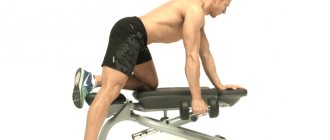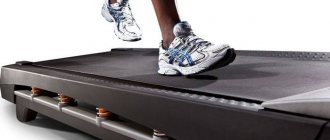HIIT (High-intensity interval training) or HIIT is an effective scientifically proven method of training, which is many times greater than long-term strength and cardio exercises. Although not everyone knows about it yet, most have already heard about CrossFit and Tabata, which can also be classified as the HIIT method. The training methods are slightly different, but there is a lot in common, the most important thing is high results with little time spent.
What is HIIT and how does the training work?
High-intensity interval training (HIIT) involves alternating short, intense periods with less intense periods for recovery. There is an alternation of, for example, twenty-second periods with maximum output (about 80-95% of maximum heart rate) and sixty second periods with lower intensity (about 50-40% of heart rate).
Typically such loads do not exceed 30 minutes. The duration of the periods may vary, the recovery period may be equal to the intensive period, or slightly exceed it.
As an illustrative example, consider training on a treadmill.
After a warm-up - walking for 5-7 minutes, a high-intensity period begins - running at maximum speed for 20 seconds, then the speed decreases to walking for one minute. And so on for 10-15 minutes.
The main difference between HIIT and long-term cardio in the fat burning mode is several times higher rates: increased speed, strength, power and accelerated fat burning.
What are HIIT workouts for?
- Firstly, such training will help in sprinting and sports where it is necessary to increase indicators such as strength and speed.
- Secondly, such training is necessary for fitness enthusiasts who have reached a “plateau” in their training.
- Thirdly, such training helps speed up the process of losing weight.
- And also the growth of muscle mass thanks to the anaerobic regime.
Research has repeatedly proven the effectiveness of HIIT. It was found that with short, high-intensity training, anabolic performance increases, without the destruction of muscle fibers, as with long-term cardio and marathons. Short workouts can preserve muscle while burning fat long after the workout is completed.
Preparing for HIIT
So, we found out that there is a more effective way to combat fat deposits than classic cardio with constant low intensity, now this must be put into practice.
To start doing HIIT you need a certain level of training. This type of training is demanding on a person’s cardiovascular system, and just suddenly starting to do high-intensity cardio is fraught with health consequences. A trained person who does not have cardiovascular diseases and has already mastered classic cardio training should start HIIT. A sufficient level of training assumes that an athlete can easily complete three low-intensity workouts lasting 60 minutes per week without experiencing any negative aspects.
You need to understand that HIIT is a different type of load, and here, as in any area, a thoughtful sequence of actions is needed. You should gradually get involved in high-intensity training. You should start with a few minutes of warm-up, as with any other workout . Warm up without much effort - warming up the joints, stretching, a dozen or two squats in place, leisurely walking for three to five minutes, or performing the planned exercise in the main part of the workout, but with 50% intensity and in a comfortable heart rate zone.
The benefits and harms of HIIT training
Why HIIT is useful:
- Increases endurance, while at the same time increasing muscle mass.
- Reduces the percentage of body fat without compromising muscle mass.
- The body uses glycogen for fuel, and HIIT helps improve insulin sensitivity, which increases the use of carbohydrates for energy. This way, fewer carbohydrates will be absorbed as fat.
- Normalizes blood pressure and strengthens the heart muscle, provided that the athlete does not have cardiovascular diseases.
- Normalizes blood cholesterol levels.
Harm and disadvantages of HIIT:
- Training is prohibited for any diseases of the cardiorespiratory system, hypertension, diabetes, coronary heart disease.
- It is not recommended to train for people who have bad habits - smoking, alcohol, as there is a risk of developing heart ischemia.
- With illiterate and long-term HIIT, there is a risk of deterioration of the heart condition, so it is important to correctly distribute the load and recover sufficiently.
- You should not exceed the number of workouts more than three times a week.
- Since training has contraindications and is dangerous for some people, you should consult a doctor before starting .
HIIT for fat burning
Circular - 3 laps
Jumping in place
- 1 set of 20 reps
- Body part: Quadriceps Equipment: Body weight
Squats without weights
- 1 set of 20 reps
- Body part: Quadriceps Equipment: Body weight
Push ups
- 1 set of 20 reps
- Body Part: Chest Equipment: No
Crunches
- 1 set of 15 reps
- Body Part: Press Equipment: No
Lunges forward
- 1 set of 15 reps
- Body part: Quadriceps Equipment: Body weight
Calf raises with dumbbells
- 1 set of 15 reps
- Body part: Calves Equipment: Dumbbells
Push-ups on a bench
- 1 set of 10 reps
- Body part: Triceps Equipment: Body weight
Plank with alternate arms
- 1 set of 10 reps
- Body Part: Press Equipment: No
Lunges with barbell to the side
- 1 set of 10 reps
- Body part: Quadriceps Equipment: Barbell
Treadmill workout
- 5 minutes in the third zone
- Body part: Quadriceps Equipment: Exercise
Add to Calendar * Add to My Workouts * Print Workout
* — The service is in beta testing
Yes, HIIT for fat burning is a very useful training for weight loss. However, you will have to approach it wisely. After all, getting a slim figure is a gradual process.
By the way, aerobic training reduces your waistline. Therefore, if you are determined to burn fat in one of 1000 ways, but have never done fitness, you will first have to undergo general physical training.
And HIIT itself will be your second step towards your dream.
How to train HIIT style
Before starting the load, you should adequately assess your own capabilities.
Remember, HIIT is a serious thing that can be both beneficial and harmful.
Therefore, stock up on a heart rate monitor, which will become your constant companion, and most importantly, will protect you from overtraining and keep your heart healthy. Another important advantage of a heart rate monitor is the accurate calculation of heart rate, which must be constantly monitored in order to increase the effectiveness of exercise. Unfortunately, you can’t track your pulse so often on your own, so buy a chest heart rate monitor - this is important!
Now you need to calculate your own heart rate zones for HIIT, this can be done using the formulas:
((Maximum heart rate - resting pulse) × intensity in %) + resting pulse;
Maximum heart rate is calculated using the formula: 220 – age.
For example , let’s take a 30-year-old man with a resting heart rate of 60 beats/min.
220 - 30 = 190 (maximum heart rate).
So, let’s calculate individual HIIT heart rate zones:
- ((190 - 60) x 80%) + 60 = 164 (maximum heart rate with HIIT) .
- ((190 - 60) x 40%) + 60 = 112 (minimum heart rate during the recovery period) .
Thus, during the intensive period, the pulse should not exceed 164 beats per minute, and during the recovery period not lower than 112 beats per minute.
For more prepared athletes, the calculation can be based on figures of 90-95% for the intensive period, and 50% for recovery.
So, we decided on the pulse. Next, you need to properly organize the training process.
- For HIIT cardio, such as on a treadmill, you need to warm up with 5 to 7 minutes of brisk walking.
- Training periods can be adjusted independently. For beginners, the best option would be this scheme: 30 seconds of running and 60 seconds of recovery.
For such a workout, 10 minutes is enough.
For more advanced athletes, HIIT can be done as follows: 30 seconds run, 30 seconds recovery. After training, you need to lower your heart rate by walking for 7-10 minutes. At the end of the cardio, you should stretch all the muscles.
Read more about post-workout stretching →
HIIT workout weeks 3.4
The ratio of work and rest is 1/2.
Total training time is 17 minutes. Circular - 5 laps
Treadmill workout
- 1 minute, 80% of your own capabilities
- Body part: Quadriceps Equipment: Exercise
Elliptical training
- 2 minutes, medium pace
- Body part: Quadriceps Equipment: Exercise
Add to Calendar * Add to My Workouts * Print Workout
* — The service is in beta testing
While doing these workouts, you can add various tools, for example, a jump rope, you can do jumping, running, or just spin an exercise bike. Use your imagination! The only thing you need is to follow the specified work-rest ratio.
Cardio HIIT workout program
In addition to the complexes given below, you can create a training program yourself, you need to change the exercises, the duration of the periods, but most importantly, take into account physical indicators, health and be sure to calculate the pulse zones .
HIIT training in video format
List of exercises for cardio HIIT
- Burpee.
- Jump rope.
- Running in place, plank, sprint.
- Any cardio equipment.
- Jumps and variations of jumps.
- Squats and jumping ups.
In fact, the list does not end with these exercises; there is a huge variety of them, so developing a workout will not be difficult.
Low load level
Complex No. 1
Perform 3 circles of 5 exercises according to the following scheme: 40 seconds of load, 40 seconds of recovery. Do the exercises one at a time. The workout will take 20 minutes.
- Burpee.
- Jumping rope.
- Running with knees raised.
- Aerial lunges.
- Plank running.
Complex No. 2
Perform five exercises in 4 circles at intervals: 30 seconds of intense period, 30 seconds of recovery. The workout will take 20 minutes.
- Jumpin Jacks.
- Jump squats.
- Plank jumps.
- Plank running.
- Jumping to higher ground.
Advanced level
Three rounds of five exercises, in each round perform an intense load for 60 seconds and recover for 30 seconds. The workout lasts 22 minutes.
- Burpee.
- Jump squats.
- Aerial lunges.
- Plank jumps.
- Jumping rope.
Program for beginners
And then the program for beginners. At first, try to combine high load with low load, in a ratio of 1:2. That is, 30 seconds of sprinting, followed by 60 seconds of fast walking. After some time, you will be able to adjust the desired load balance yourself. This is regulated by heart rate; it is necessary that the pulse returns to normal during a decrease in intensity. A beginner will only need 4-5 intervals per cardio session. What is one interval? 30 seconds of sprinting + 60 seconds of fast walking will count as 1 interval. In the future, you can increase the number of intervals and vary the combination of periods of stress and rest. For example, the next stage of intensification could be the same 30 seconds of sprinting, but in combination with 15-20 seconds of fast walking. The number of intervals can also be increased, but it is worth remembering that HIIT is quite energy-intensive and you should not go too far; focus on a cardio session of 20 minutes, taking into account the time for warm-up and cool-down. The same thing is suitable for a cool-down as for a warm-up.
HIIT Strength Training Program
Strength training differs from HIIT cardio in that strength exercises are performed with a weight that is suitable for a maximum of 5-8 repetitions. Each exercise is performed one after another without a pause, but at the end of the circle you need to recover for 2-3 minutes. Do not perform more than 4 laps. The optimal duration of such a workout is 15 minutes.
An example of a strength complex for those who are trained:
- Sumo squats – 5-8.
- Lunges alternately forward – 8.
- Good morning – 5-8.
- Thrusters – 5-8.
- Deadlift – 5-8.
- Barbell row to the belt – 5-8.
As for strength training, the list of exercises here is also quite diverse. To begin with, it is important to warm up the ligaments, muscles and joints well. The weight of the load must be added gradually as the complex is completed. It is important to do the exercises quickly, but not to lose quality.
Secrets of Interval Training
For HIIT, burning 2% body fat in 8 weeks couldn't be easier.
And this was scientifically proven in 2001. Participants in a study at East Tennessee State University in the United States who did a HIIT program actually experienced a 2% fat loss over 8 weeks.
- Australian scientists found that women who did 20 minutes of high-intensity interval training, which alternated between 8 seconds of sprinting and 12 seconds of rest, burned six times more fat than participants who did 40 minutes of constant-intensity fat-burning cardio.
- The main reason why high-intensity training has a fat-burning advantage over steady-intensity training is the increased metabolism after HIIT. After high-intensity training, your body continues to burn calories for another whole day! This was proven by a study conducted in 1996 at Baylor College of Medicine, Houston, Texas, USA. The subjects who did a high-intensity interval training program on exercise bikes burned significantly more calories in the 24 hours after the workout than the participants who exercised as usual!
- In addition to boosting your metabolism, high-intensity interval training boosts your metabolism, which helps burn fat and prevent fat storage. The process of lipid oxidation—that is, fat burning—in your muscle fibers occurs faster if you engage in high-intensity training.
- Reduce fat-storing enzymes. A study conducted at the Norwegian University of Science and Technology in Trondheim shows that HIIT can reduce fat-storing enzymes. Metabolic syndrome participants showed 100% greater reductions in fat-storing enzymes after 16 weeks of high-intensity interval training than their counterparts after a steady-state, moderate-intensity program. Sounds amazing, right?
But there's more evidence that high-intensity interval training is effective at burning fat forever.
Interval Aerobic Training
Interval aerobic training speeds up the fat burning process and also trains the cardiovascular system. Your endurance will improve much faster than long-term cardio! Habitual long-term aerobic exercise is largely inferior to IT in effectiveness, but can act as a preparation for this method.
This interval training program involves relatively long periods of work and shorter periods of rest. Intervals of increased activity last about 2-5 minutes. The point is that you should be working at such an intensity that you are able to finish the interval, rather than training to the limit. Thus, the pace of the 2-minute phase will be significantly higher than the pace of the 5-minute phase.
The rest period in this type of training lasts from 30 seconds to 1 minute. In general, the shorter the rest, the more difficult the workout. Rest for too long allows the body to recover more, thereby reducing the overall effect of the workout.
If you're a beginner, start with interval aerobics! In aerobic interval training, you can stick to the following time intervals: for example, 2 very intense minutes, and 30 seconds less). Typically, aerobic interval training lasts 20-30 minutes. Having mastered this program, you can safely move on to interval training.
What is HIIT
The American College of Sports Medicine (ACSM) brochure defines HIIT as a training strategy in which short, intense training periods are followed by less intense recovery periods . An example of HIIT is alternating 20-second sprints with 60-second brisk walking for 10 minutes. This training strategy is used in both aerobic (cardio) and anaerobic (strength) types of training.
Most endurance training, such as brisk walking, running, and stair walking, is performed at a constant moderate intensity at approximately 60-65% of your maximum heart rate. These workouts last quite a long time - 40 minutes or longer.
The HIIT method professes a completely opposite training principle. During training, periods of intense work are performed with efforts ranging from 80-95% of the maximum heart rate and can last from 5 seconds to several minutes. They are followed by periods of recovery, which can last about as long as periods of intense work (but may be shorter or longer).
During the recovery period, work is usually performed within 40-50% of the maximum heart rate. Workout duration can range from 4 to 60 minutes, but most HIIT workouts are short, lasting 15-30 minutes.
Dumbbell exercises for the whole body
This workout should replace your boring circuits in the gym, if you still do them. The workout will take half an hour of your time, and you will need to do 5 rounds of exercises, which are presented below.
| Time | Exercise |
| 1 min | Burpee |
| 1 min | Rest |
| 30 sec on each side | Dumbbell lunge combined with biceps curl and dumbbell press |
| 1 min | Rest |
| 1 min | Full press-ups from a lying position with dumbbells |
| 1 min | Rest |
Most people have legitimate questions about how to fit this into a fitness professional's regular training program. There may be several options:
- You completely stop doing regular gym exercises and do full body HIIT 3-4 times a week. On free days - walking, stretching, yoga if desired, or just nothing. This will give a change of focus and a break from heavy weights, restoration of ligaments, and possibly good results in fat burning if the diet is on point. This is how you can spend your summer vacation, or study when the annual cycle has ended and you need to open up new horizons for yourself;
- One HIIT workout replaces a regular circuit workout in a split. For example, you standardly train chest and triceps on Monday, back and biceps on Wednesday, and legs and shoulders on Friday, and on Sunday you perform one complex in the fresh air, at home or in the gym, if you’re not too lazy to go there. This option is suitable for those who are trying to gain lean mass, or are doing well on their diet, but are quickly losing muscle;
- Hybrid training style, that is, 1-2 basic exercises, plus a HIIT complex for the whole body, either “bottom” or “top” in one workout. Then the basic exercise is performed not in multi-repetition mode, but in power mode, for a maximum of 5 repetitions. This option is considered the best metabolic scheme for the prepared. That is, when the usual split and cardio no longer allow you to “dry out” into cubes, you can use something like this
Short HIIT is also used as a “finisher” instead of cardio. On average, the average person needs 2-4 HIIT workouts per week. More specific recommendations can be made if you try this style of training for several weeks.











